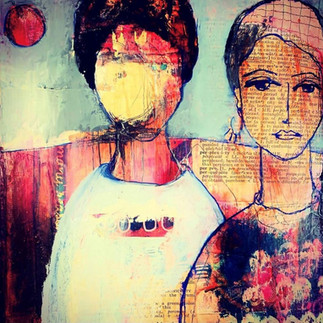Small art space? here's how to make the most of it.
- Kasia Avery
- Nov 12, 2021
- 6 min read
Updated: Sep 30
Our art spaces play a big role in our creative practices. Our surrounding influences our art and it's important to make it work for us. Especially when it's small!
Today I bring you an interview with Soraya Nulliah, one of Wanderlust 2022 Teachers, who recently moved to a different country and had to create her new art space from scratch.
KA: Can you tell us a little bit about the kind of art that you enjoy creating the most?
SN: The art that’s closest to my heart is art journaling. It’s my very first form of artistic expression. I began in my early teens before I even knew it was a thing.
I survived an extremely abusive and toxic childhood and art journaling became a tool for me to not only express my experiences, but also to heal and empower myself. It became a lifeline.
I began by simply writing but then, organically, I added drawings, doodles and sketches to my pages. A friend of mine gifted me with an art supply set. It was very basic but it was all I needed to begin creating more visual pages. Present day, I love art journaling for those exact same reasons as when I began. There’s an alchemy that occurs when I combine art and words; it’s a truly transformative art form that continues to evolve as I do. It allows me unparalleled freedom and is perfect for playing and experimenting.
KA: This sounds like an incredible journey. Thank you for sharing! I know that you have recently moved to a different country with your family. Can you tell us more about when and where have you moved to?
SN: We moved to Italy a little over 3 months ago. We live in the northern region (the Venetto) which is truly spectacular. Whilst it has definitely been stressful, as all moves generally are, it’s an absolute dream come true! To be living in the presence of artistic traditions that go back centuries is both an honor and a privilege.
KA: I love Italy. It's so unbelievably inspiring! I'm not surprised you chose it as your place to live, but I can believe the move must have been a massive logistic operation. I’m guessing setting up your art space wasn’t on top of the priority list and you had to sort out your living spaces first. I know that you’re getting there now though. First can you tell us what was your art space like at your previous place?
SN: I was very fortunate in that my previous art space was relatively large and all mine. It was a den in our home, had 2 walls of large windows with gorgeous light and a fireplace! It measured about 12 x 15 feet and had high ceilings. A lot of my furniture pieces in my studio were very pretty but they didn’t hold much stuff.


KA: Looks wonderful and vibrant! Just like your art! Can you tell us how long it took to start thinking about setting up your current art space? And how did you find this time of transition as an artist?
SN: As soon as we began looking for rentals I started thinking about my art space. Of course there were many factors involved but if there was a place that was perfect in every other way but couldn’t accommodate my art, then we passed on it.
I always travel with a couple of sketchbooks/art journals so I managed to create in between moving. A small set of watercolors, a few pens/pencils, some collage/epherema and a glue stick was what I had. Over the years I’ve worked at developing a creative habit every single day so it was a part of my routine I was able to maintain.
KA: I love your attitude! What does your new art space look like right now?
SN: While my new art space isn’t completely functional yet, I’m starting to love it! The room itself is quite small (roughly 9x9 feet) but it’s all mine and I’m grateful . I immediately knew that I would have to utilize my space effectively so I turned to Ikea for storage solutions . I have 3 separate Kallax units and they give me plenty of space. A third of my art studio also houses my clothing because most homes in Italy don’t have closets. My main concern right now is my lighting because in addition to the fact that I only have one small window, none of my art lights from N America work here. Let me add that while I wanted to make the most of the space I had, I didn’t want to fill up every square inch with stuff. I wanted some breathing room. It’s a personal preference. So I am keeping my walls relatively bare and I’ve organized my art supplies in a way where there’s still space in the shelves.



KA: I love it! And nothing can beat an Ikea storage, right? I love how you kept some "breathing space", while at the same time surrounding yourself with lots of pretty little things. We often think that we need more and bigger spaces in order to create art. We see these beautiful lofty rooms on Pinterest and Instagram and within them the eager artists in their perfect flow. But the reality for many of us is very different. What are your thoughts on that? Does the size of space that you have constrain the quality of your art process?
SN: My personal experience has taught me that it’s easy to get caught up in having or creating the perfect art space. But the truth is that we create when and where we can. When I was a teen, I had no art studio or personal space to create, so my art journal became my portable studio. Of course there are practical constraints such as if I wanted to paint huge canvases but I had a tiny closet that was my art space, I may face some challenges! But for the most part, if we have the impulse to create, we can adapt our art to the space we have available to us.
KA: With small art spaces we have to make sure that every inch of them works hard. Can you give us any tips on storage and organising your supplies or artwork?
SN: The elements that build a satisfying and fun art process for me are having the time to create and having my art supplies easily accessible. Nothing is more frustrating than being in the middle of painting and I either run out of time or I can’t find an art supply I need. I solve this, I make sure I utilize my time effectively so for instance, if I only have 15 minutes in my studio I’ll work on laying down some inks and collage rather than working on a face which requires more time and effort. I also organize my art supplies so I can easily access them.
For me, storage and organisation break down into 3 aspects:
Utilizing the space I have in the most efficient manner. For instance, if I have a lot of vertical space, how can I use it?
Simplify. I don’t need every art supply out there; sometimes less is more. And I find that if I have too many art supplies, it actually hinders my process.
I need to organize my art supplies in a manner where I can easily access them because there’s no point in having an art supply if I can’t find it or forget I even have it! I can organize by color, function or brand ; it doesn’t matter as long as it works for me.

KA: Great tips! And what elements make your art space feel like “home”? What do you do to make it more personal and to connect to it better?
SN: For me it’s so important to make my art space feel homey so I add all the things I love...string lights, a favorite coffee mug, family photos, art postcards, a travel souvenir, a fresh flower. I want my space to be warm and inviting to me, that way I’ll spend more time in there creating. Also, I prefer my art space relatively clean and tidy.
KA: Thank you Soraya for sharing your thoughts on making our art spaces work for us!


Isn't it amazing how much personality Soraya managed to inject into a completely new space and in such relatively short time? It just shows that an art space, however small, can be made personal and functional.
















Enjoyed this interview a lot as at times we think we need to have everything, space, storage - but then can’t find anything! So less can be more - note to self, lol.